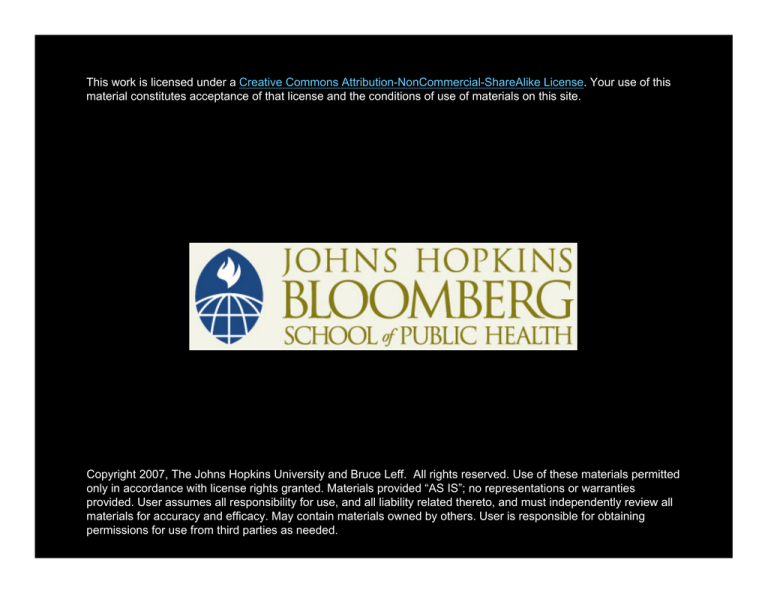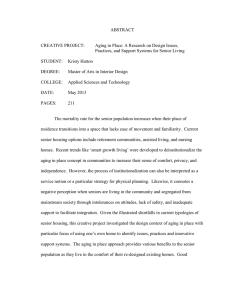
This work is licensed under a Creative Commons Attribution-NonCommercial-ShareAlike License. Your use of this
material constitutes acceptance of that license and the conditions of use of materials on this site.
Copyright 2007, The Johns Hopkins University and Bruce Leff. All rights reserved. Use of these materials permitted
only in accordance with license rights granted. Materials provided “AS IS”; no representations or warranties
provided. User assumes all responsibility for use, and all liability related thereto, and must independently review all
materials for accuracy and efficacy. May contain materials owned by others. User is responsible for obtaining
permissions for use from third parties as needed.
Biological and Clinical Aspects of Aging
Bruce Leff, MD
Associate Professor of Medicine
Division of Geriatric Medicine,
Dept Health Policy & Management
Let’s Think About…
• What aging is
• Physiological changes of aging
• Normal, usual, successful aging
• What is frail?
• Chronic conditions
• Policy implications
What is Aging?
Politics, funding, industry
Normal Physiologic
Outcome
•Wear and tear
•Part of living and being
Pathologic
Outcome
•Cumulative interplay of
diseases – influence of
genes, environment, & time
What is Aging?
• Aging is a process that converts fit adults into frailer
adults with progressively diminished reserves and
increased vulnerability to illness, injury, and death
• Occurs at all levels:
– Molecule to cell to organ to organism
• Inevitable and universal
• All organisms have finite life span
Normal Aging
• Universal age related changes
• Puberty
• Menopause
• Death
• Loss of homeostatic reserve - loss of
ability to buffer insults
Quiz
• What birthday should you celebrate to recognize
that you are now “over the hill?”
a. 21?
b. 35?
c. 50?
d. 65?
e. 80?
Which Birthday to Celebrate?
100
90
80
70
21
35
50
65
60
50
40
30
20
10
0
0
20
35
50
65
85
95
Usual Aging
Age-related changes that commonly occur –
not necessarily universal or age determined
Features of Usual Aging
100
90
Decline Without Plateau
% remaining
80
70
60
50
Cardiac
Index
40
GFR
30
20
FEV1
Early Rapid Growth
10
0
0
10
20
30
40
50
Age
60
70
80
90
Features of Usual Aging –
Variability in Decline
140
120
CrCl
100
80
60
Variability from organ to
organ, individual to individual
40
20
0
35
45
55
65
Age
75
85
Implications of Usual Aging
• Increased differentiation and variation between
and within individuals – central feature of aging
• Atypical presentations of disease
• However, aging is influenced significantly by
lifestyle circumstances
– smoking, exercise, nutrition, SES
• Increased vulnerability to stressors
Usual Aging - Limitations
• Implication of harmlessness or unmodifiability
• “What do you expect at your age…”
• “What should I expect at my age…”
Successful Aging
• Meaning unclear
– Beyond health and
longevity
– Capacity to function across
many domains – cognitive,
social, emotional
• Influence of other factors
• MacArthur studies:
importance of exercise,
social network, social
support, and income
Vintage Running CC BY-NC-ND
What is Frail?
• Increased vulnerability
• More than disease, more than just disability
• Critical to define for research and for health
planning needs
One Research Definition of Frail
• Clinical syndrome (>3 factors):
– unintentional weight loss (>10 lb yr)
– weakness - grip strength
– slow walking speed
– self report exhaustion
– low physical activity
• Prevalence in community 7%, 4 year incidence 7%
• ↑ with age, women, AA, low educ & income, comorbidity, and
disability
• Overlap, but not concordance in frailty, comorbidity, disability
• Predicts falls, disability, hospitalization, death
Process of Aging - Quiz
•
What has happened
to the average and
maximum life span
over the last century?
A. Increased average,
increased maximum
B. Increased average,
decreased maximum
C. Increased average,
unchanged maximum
Jeanne Calment, died age 122
100
90
80
70
60
50
40
30
20
10
0
0
10
90
80
70
60
50
40
30
20
1900
1990
Ideal
10
Bi
rt
h
% Survival
Survival Curves - Max and Mean Survival




